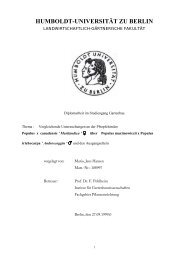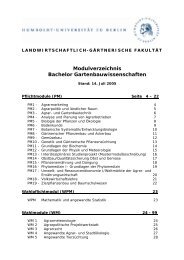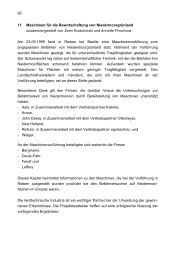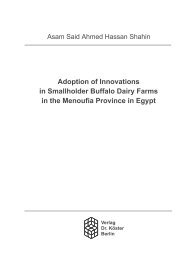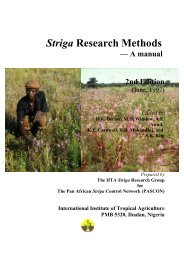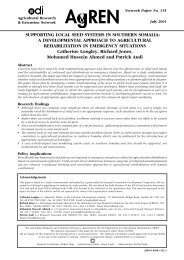Rice-Wheat Cropping Systems of the Indo-Gangetic Plain of India
Rice-Wheat Cropping Systems of the Indo-Gangetic Plain of India
Rice-Wheat Cropping Systems of the Indo-Gangetic Plain of India
Create successful ePaper yourself
Turn your PDF publications into a flip-book with our unique Google optimized e-Paper software.
temperatures also could be ano<strong>the</strong>r factor.<br />
But <strong>the</strong>re seems little scope for making any<br />
significant breakthrough, except by way <strong>of</strong><br />
shifting some area from wheat to o<strong>the</strong>r less<br />
water requiring crops and confining wheat<br />
cultivation to heavy soils <strong>of</strong> good moisture<br />
retentivity; and streng<strong>the</strong>ning <strong>of</strong> irrigation<br />
supplies, wherever, possible.<br />
Productivity <strong>of</strong> <strong>the</strong> <strong>Rice</strong>-<br />
<strong>Wheat</strong> <strong>Cropping</strong> System<br />
The total productivity <strong>of</strong> rice + wheat<br />
(R+W) in <strong>the</strong> rice-wheat growing areas <strong>of</strong><br />
<strong>the</strong> IGP is depicted in Figure 8. An<br />
interesting picture emerges upon plotting<br />
<strong>the</strong> total rice and wheat productivity <strong>of</strong><br />
RWCS specific to <strong>the</strong> R-W growing areas.<br />
A solid compact block <strong>of</strong> very high<br />
productivity <strong>of</strong> 7–8 t/ha <strong>of</strong> rice + wheat is<br />
found concentrated in <strong>the</strong> Trans-<strong>Gangetic</strong><br />
<strong>Plain</strong> Region VI (Punjab-Haryana). On <strong>the</strong><br />
periphery <strong>of</strong> this very high productivity<br />
block, lies <strong>the</strong> next high productivity area<br />
<strong>of</strong> 6–7 t/ha which comprises <strong>the</strong> districts <strong>of</strong><br />
Gurdaspur on <strong>the</strong> north-west and parts <strong>of</strong><br />
Haryana (A4) and little fur<strong>the</strong>r below in<br />
South-West Uttar Pradesh, <strong>the</strong> district <strong>of</strong><br />
Aligarh. This is followed by zone <strong>of</strong> 5–6 t/<br />
ha comprising parts <strong>of</strong> Zone A4 <strong>of</strong> Haryana,<br />
mid-upper part <strong>of</strong> Western Uttar Pradesh,<br />
Zone B1, Tarai Region B2, and South-<br />
Western parts <strong>of</strong> B4 on <strong>the</strong> eastern flanks.<br />
Next to <strong>the</strong>se high productivity zones,<br />
north-eastward and south-eastward lies a<br />
fourth zone <strong>of</strong> high productivity. This<br />
encompasses <strong>the</strong> large number <strong>of</strong> districts <strong>of</strong><br />
zones B2, B4 and B3 with average R+W<br />
productivity <strong>of</strong> 4–5 t/ha. Ano<strong>the</strong>r similar<br />
productivity area is apparent in (i) sou<strong>the</strong>rn<br />
Bihar (ii) south-eastern Uttar Pradesh (iii)<br />
north-eastern parts and in central districts<br />
<strong>of</strong> Uttar Pradesh <strong>of</strong> Faizabad, Barabanki,<br />
etc. A similar range <strong>of</strong> productivity (4–5 t/<br />
ha) is also observed in West Bengal ACZ<br />
D1 (Old and New Alluvial <strong>Plain</strong> Zones), as<br />
well. Elsewhere, <strong>the</strong> total rice +wheat<br />
productivity continues to be dismally low,<br />
i.e. less than 3 t/ha, as in eastern Bihar,<br />
and 3–4 t/ha as observed over most <strong>of</strong> <strong>the</strong><br />
eastern and central Uttar Pradesh, sou<strong>the</strong>rn<br />
Uttar Pradesh, and western Bihar. Thus,<br />
high productivity <strong>of</strong> rice and wheat seems<br />
to go hand-in-hand across <strong>the</strong> IGP. Low<br />
productivity seems positively correlated with<br />
flood-prone areas (Fig. 9b).<br />
Time-trends in <strong>Rice</strong> and <strong>Wheat</strong><br />
Temporal trends <strong>of</strong> area, production and<br />
productivity <strong>of</strong> rice and wheat based on 3year<br />
moving averages along with compound<br />
growth rates are depicted in Figures 10–16.<br />
The detailed analysis for various regions is<br />
as under:<br />
<strong>Rice</strong><br />
ACR VI—Trans-<strong>Gangetic</strong> VI Trans-<strong>Gangetic</strong> <strong>Plain</strong> Region<br />
(Punjab and Haryana): The rice crop<br />
continues to show an overall steady increase<br />
in area, production and productivity in this<br />
agroclimatic zone, <strong>the</strong> primary Green-<br />
Revolution region in <strong>India</strong> (Fig. 10).<br />
Although productivity appears to be getting<br />
plateaued from <strong>the</strong> 1980s, <strong>the</strong>re are no<br />
declining trends observed for any <strong>of</strong> <strong>the</strong>se<br />
three parameters viz., area, production or<br />
productivity, which are vitalfrom <strong>the</strong><br />
national food security point <strong>of</strong> view.<br />
27



